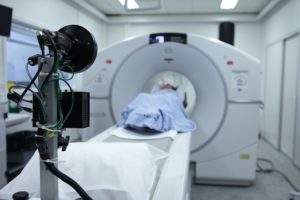APPLICATIONS OF TECHNOLOGY:
- Radiation detectors
- Positron emission tomography (PET) systems
BENEFITS:
- High fidelity position, energy, and time information provided
- Lower cost than silicon photomultipliers
- Reduced signal processing footprint
BACKGROUND:
- Radiation detectors work by turning incoming radiation into electrical signals, and information about the radiation is deduced from the nature of the interaction with the detector. Scintillation detectors are a special kind of radiation detector that measure radiation indirectly, by detecting a flash of light produced by the interaction of the incoming radiation with the detector material.
TECHNOLOGY OVERVIEW:
Berkeley Lab researchers have created a new detector concept, as well as techniques for signal processing and data transmission for direct digitization of single light photons for scintillation and Cherenkov detectors. By coupling a scintillation crystal to an array of analog silicon photomultipliers processed with low-noise high frequency electronic readout, single light photons can be counted as they arrive at the photosensor array. Ionizing radiation time of interaction can be estimated by accounting for delays in light and charge travel time, and three dimensional positioning allows for estimation of position within the scintillation detector. Single light photons are directly digitized from this detector with gigabit transceivers in FPGA. This system enables high precision position, time, and energy information, making it optimal for use in high-performance light detection and imaging applications.
DEVELOPMENT STAGE: Characteristic proof of concept
PRINCIPAL INVESTIGATORS:
- Joshua Cates
- Woon-Seng Choong
- Erik Brubaker
STATUS: Patent pending.
OPPORTUNITIES: Available for licensing or collaborative research.
